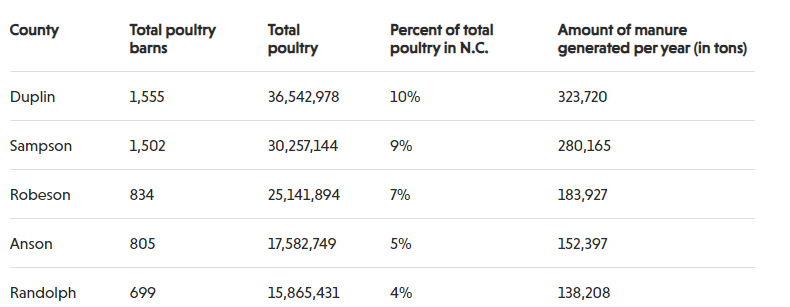By Sarah Graddy
A new EWG investigation has used artificial intelligence to find poultry farms in North Carolina housed almost 357 million chickens and turkeys as of 2022 – about 33 birds for every human.
That’s a 43 percent increase since 2007, when there were about 250 million birds.
EWG examined aerial imagery from the Department of Agriculture with machine learning, a type of AI, to identify active poultry operations and determine the number of birds they likely had or have. This method is more accurate than those used in past studies.
The findings provide up-to-date and accurate data about poultry factory farms, crucial because North Carolina’s agencies don’t track their location or size. And the state does very little to regulate how they’re run or where their copious amounts of manure end up.
People who live near factory farms risk getting sick from drinking contaminated water and developing asthma and other respiratory problems from breathing polluted air.
Other dangerous phenomena that can be attributed at least in part to poultry operations include antibiotic-resistant bacteria, toxic algae blooms and global pandemics such as bird flu.
North Carolina’s lawmakers and agencies must implement strong regulations on poultry concentrated animal feeding operations, or CAFOs, and protect residents from their many harms.
Five counties represent bulk of booming poultry industry
Across North Carolina’s 100 counties, the five with the most poultry are Duplin, Sampson, Robeson, Anson and Randolph. Together, they account for more than 35 percent of the state’s birds.
The map below shows where poultry was most concentrated in the state in 2022.
Duplin and Sampson counties alone have almost one-fifth – 19 percent – of all the poultry.

EWG identified a 43 percent increase in the state’s poultry population between 2007 and 2022 – from 249,795,021 birds to 356,808,908.
But the increase in poultry was not evenly distributed across North Carolina – far from it. In four of the top five poultry counties, the rate of growth was much steeper than in the rest of the state.
Looking at only Duplin, Sampson, Robeson and Anson counties, the average growth between 2007 and 2022 was 98 percent.
And when EWG calculated the state’s average growth excluding those four counties, it dropped from 43 percent to 27 percent.
In total, more than half – 50.6 percent – of all new poultry in the state over the 16-year period analyzed appeared in those four counties alone.
In the fifth county, Randolph, poultry grew by just 10 percent. Notably, Randolph’s population is 75 percent white – by far the highest proportion of white people of the top five poultry counties, the 2020 U.S. Census shows.
In North Carolina, the disastrous effects of large CAFOs are more likely to harm communities of color, as a 2020 EWG investigation spotlighted. (Many other studies have also described this troubling and unjust trend.)
Over 3.2 million tons of fowl waste fouls the state
According to EWG’s calculations, North Carolina’s 357 million chickens and turkeys produce over 3.2 million tons of manure in 2022. That’s about the weight of almost 970,000 Tesla Cybertrucks.
Poultry manure is loaded with chemicals like nitrogen, phosphorus and ammonia. It also carries dangerous pathogens like giardia, E. coli, salmonella and cryptosporidium.
Poultry manure is typically managed as “dry” waste, euphemistically called “litter.” The animals’ feces are gathered into open-air, putrid heaps together with bird carcasses, feathers and bedding. These mounds can be enormous.
North Carolina regulations allow the waste to be stored in uncovered piles for up to 15 days at a time – though authorities rarely enforce even this limit as the advocacy group Waterkeeper Alliance has repeatedly documented.
This manure and other material is applied, untreated, to crop fields as fertilizer, in many cases just to dispose of it, regardless of whether plants need it. And no one tracks where it’s spread – let alone how much is applied in any given area.
Poultry factory farms pollute water – including wells
The enormous amounts of manure created by North Carolina’s poultry factory farms threaten water quality across the state, particularly in areas where operations are most concentrated.
A 2022 EWG investigation spotlighted the risk of flooding faced by poultry and swine CAFOs in North Carolina, finding that 156 were located in or just outside of floodplains – and that many more facilities were likely also at a high risk of flooding. Thanks to the climate crisis, extreme catastrophes like flooding are becoming more common in many places.
Even without such events, the dangers that CAFOs pose to humans and the environment are ever-present.
Manure that washes or blows off farm fields or CAFOs can pollute waterways, harming wildlife, feeding toxic algae blooms and contaminating rivers used to supply drinking water to utilities.
It can also taint private wells, causing severe gastrointestinal issues and even death for people who consume that water.
About 2.4 million North Carolinians, or more than one in five residents – more than almost any other state – rely on private wells for their drinking water, according to the state Department of Health and Human Services. Many wells are rarely or never tested, let alone treated, for contaminants.
One 2016 Duke University study found that more than 30 percent of CAFOs in the state can be found in areas where over 96 percent of residents depend on well water.
Click here to see more...